
Asterivora colpota is a moth in the family Choreutidae. It was first described by Edward Meyrick in 1911. It is endemic to New Zealand and is found throughout the North and South Islands. It is regarded as a lowland species and adults are on the wing from November until March. This moth has been collected by beating shrubs.

Izatha apodoxa is a moth of the family Oecophoridae. It is endemic to New Zealand, where it is known from scattered localities in the southern North Island. This species is variable in appearance and comes in two forms, a grey form and a black and white form. In the grey form it is very similar in appearance to I. notodoxa and in the black and white form to I. katadiktya. At present the larvae and biology of this species is unknown.
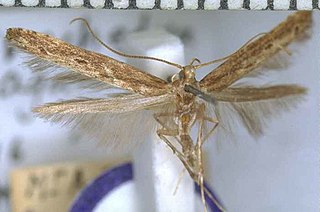
Batrachedra agaura is a species of moth in the family Batrachedridae. It is endemic to New Zealand. This species is distributed throughout the country. The species inhabits native forest especially beech and kanuka forest or manuka scrubland. The larvae of this species is associated with sooty mold and with sooty beech scale. It has been hypothesised that the larvae feed on sooty beech scale. However they may also feed on the sooty mold itself. The adult female is lighter in appearance than the male and the species shows considerable variation in patterns on forewing. Adults are on the wing from October to February. They are nocturnal and occasionally attracted to light.

Heterocrossa iophaea is a species of moth in the family Carposinidae. It is endemic to New Zealand.

Glyphipterix achlyoessa, commonly known as the cocksfoot stem borer, is a species of moth in the family Glyphipterigidae. It is endemic to New Zealand and can be found throughout the country. This species inhabits meadows and open grasslands. The larvae are hosted by species in the genus Juncus as well as by the species Dactylis glomerata. Adult moths are commonly on the wing from October to December.
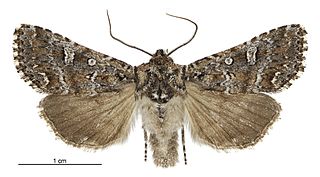
Ichneutica lithias is a moth of the family Noctuidae. This species is endemic to New Zealand. It is a small moth but distinctive as a result of the markings on its forewings. Although this species is widespread in the South Island, it has only been collected in the Rangipo Desert in the North Island. The species prefers habitat that is scrubland ranging in altitude from coastal to alpine. Adults are on the wing from October to April and larvae have been collected and reared on the New Zealand endemic plant species Melicytus alpinus.

Ichneutica petrograpta is a moth of the family Noctuidae. This species is endemic to New Zealand where it is found in the southwest districts of the South Island, including Westland, Otago Lakes and Fiordland. It is very similar in appearance to I. mutans. It inhabits tussock and shrubland in the alpine to subalpine zones. Adults of I. petrograpta are on the wing from December to February and are attracted to sugar traps. The life history of this species is unknown as are the host species of its larvae.
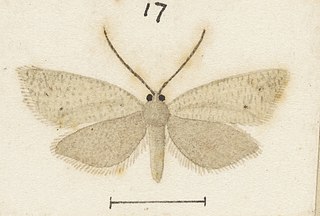
Ericodesma aerodana is a species of moth of the family Tortricidae. It is endemic to New Zealand and is found in the North and South Islands. The species inhabits sand dunes and larvae feed on Pimelea prostrata. Adults are on the wing from October to January and are active at twilight. This species is classified as "At Risk, Declining" by the Department of Conservation as its larval host plant is under threat from habitat loss and the invasive to New Zealand plant, sea spurge.

Culladia strophaea is a species of moth in the family Crambidae. It is endemic to New Zealand. The taxonomy of this species is currently uncertain.
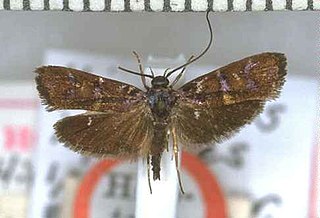
Hierodoris iophanes is a moth of the family Oecophoridae. It was described by Edward Meyrick in 1912. This species can be distinguished from others in its genus by the purple metallic colouration as well as the blue-white mark on its forewings. It is endemic to New Zealand, where it has been recorded from Auckland to Southland. This species inhabits native forest or scrub, with the adults preferring open glades. They are known to be on the wing from November until February and fly during daylight hours, being active on hot sunny days. Larvae feed on the interior of twigs of Prumnopitys ferruginea. The twigs had evidence of oviposition scars of cicadas and the larvae were collected in October after reddish-brown frass indicated their location within the twigs.

Asaphodes abrogata is a moth in the family Geometridae. It is endemic to New Zealand and can be found from the central North Island as well as the South Island. This species is inhabits open country at altitudes of between 2000 and 4000 ft. Larvae have been reared on Plantago species including Plantago coronopus. It has been recommended that Plantago raoulii be planted to attracted this species. Adults are on the wing in February and March.
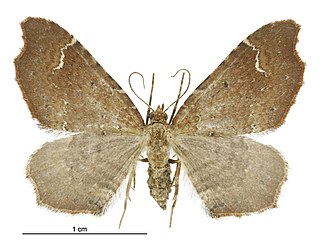
Asaphodes camelias is a species of moth in the family Geometridae. It is endemic to New Zealand and inhabits native forest. The adults of this species are on the wing from February to May and July to September.

Xanthorhoe lophogramma is a species of moth in the family Geometridae. It is endemic to New Zealand. It is classified as "At Risk, Nationally Uncommon" by the Department of Conservation.

Asaphodes dionysias is a species of moth in the family Geometridae. This species is endemic to New Zealand and is only known from mountainous areas in Central Otago. It lives in open grassy mountainous habitat at altitudes up to 1750 m. It is also known to live in wetland habitat. The larvae of this species feed on native herbs. The adults of this species are on the wing in January and February. The adult female of the species has reduced wing size in comparison to the male.

Notoreas ischnocyma is a species of moth in the family Geometridae. This species is endemic to New Zealand. This species is found in Canterbury and Otago.

Notoreas mechanitis is a species of moth in the family Geometridae. It is endemic to New Zealand.

Zapyrastra calliphana is a species of moth of the family Momphidae. It was first described by Edward Meyrick in 1889. It is found throughout New Zealand including at the Manawatāwhi / Three Kings Islands as well as at the Norfolk Islands. The preferred habitat of this species are native forest clearings, shrubland or coastal habitat such as scrub or dunes. The larvae of this species are leaf miners and are hosted by Muehlenbeckia species. There are likely several generations during the New Zealand summer and one generation overwinters as pupae. This species is a day flying moth and adults can be observed on the wing from October to March.
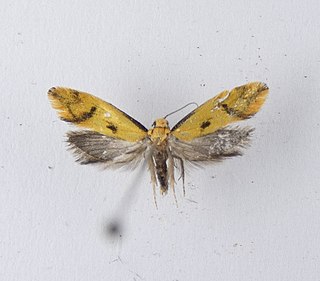
Tingena actinias is a species of moth in the family Oecophoridae. It is endemic to New Zealand and is found on the North and South Islands. The larvae of this species are leaf litter feeders. The preferred habitat of this species is shrubland and it has also been observed in gumland heaths and in beech forest.
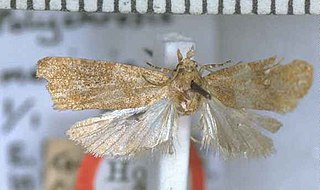
Polychrosis meliscia is a species of moth of the family Tortricidae. It is found in New Zealand at the Kermadec Islands.
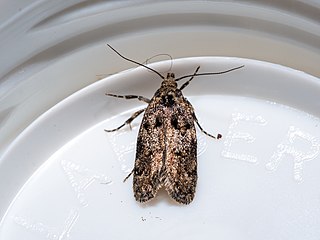
Trachypepla anastrella is a species of moth in the family Oecophoridae. It is endemic to New Zealand and has been observed in the North and South Islands. Larvae are leaf litter feeders from the host plant Olearia fragrantissima and adults are on the wing from December until March.





















